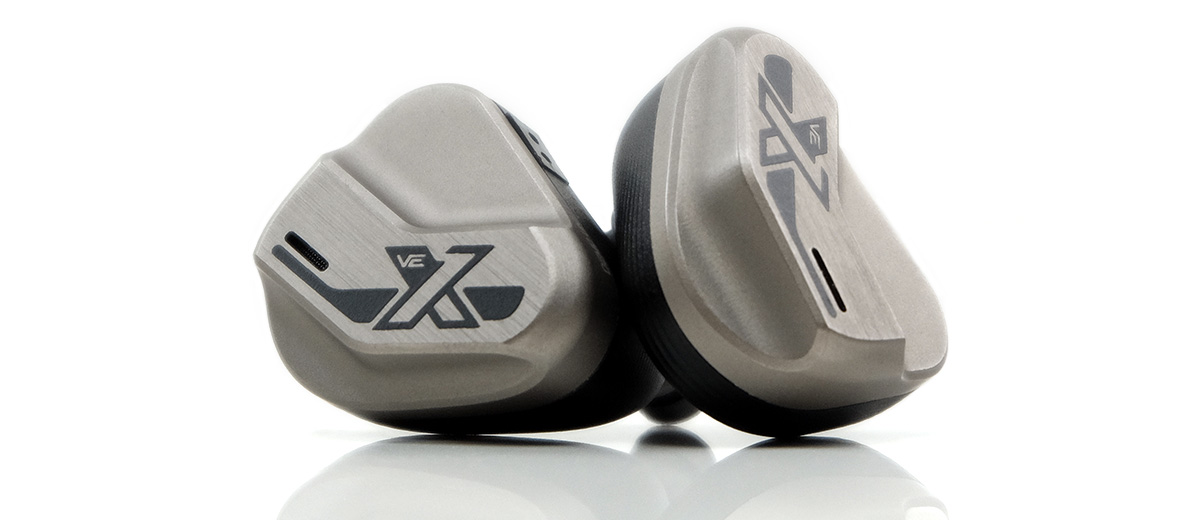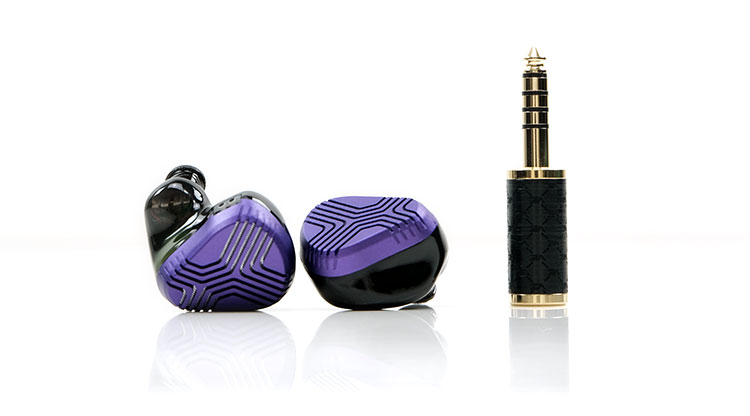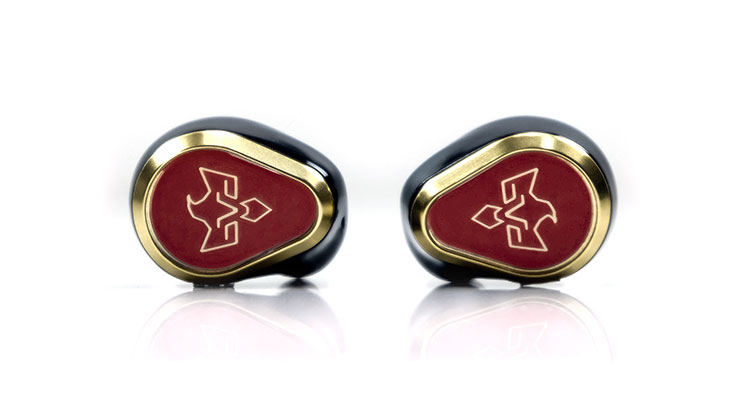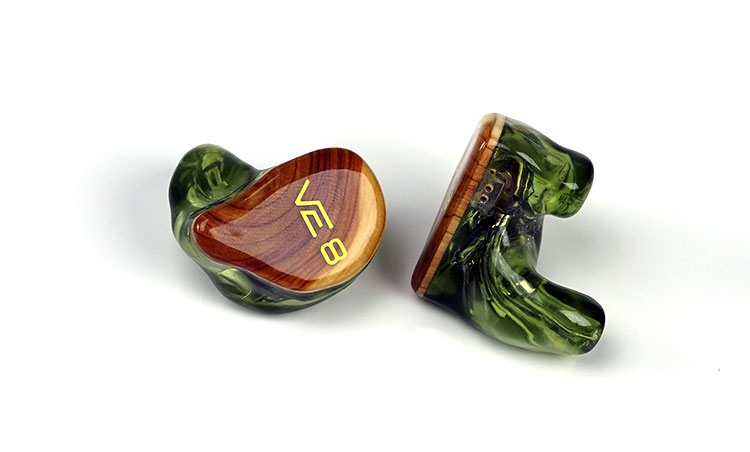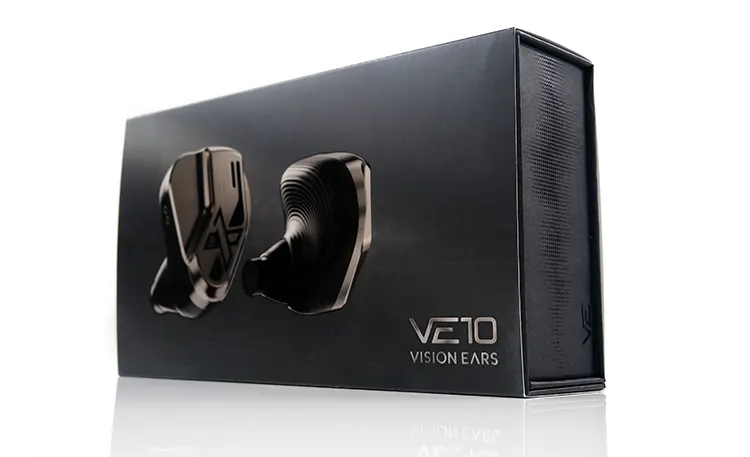Select Comparisons
The following comparisons to the VE10 were completed using a mixture of the HiBy R8 II and Cayin’s N8ii DAPs with both set to low gain Turbo and P+ modes and using their 4.4mm balanced outputs.
The compared IEMs were equipped with their stock cables with the EXT on SpinFit Cp145 tips and the Phonix on its stock AZLA SednaEarfit Crystal tips. The tips on the VE10 were the stock AZLA Origin tips.
Vision Ears EXT
The Vision Ears EXT was launched in 2021 and is an evolution of the previous Elysium engineering. We reviewed the EXT towards the end of 2021 and it was a co-awardee Universal IEM Top Gear winner for that same year.
Technical
Internally, the EXT has a lower driver count but the configuration and thinking is a very different proposition to the VE10.
The genesis of the EXT comes from the older Elysium’s unique use of a dynamic driver for the mids but where the Elysium has a BA for the lows, the EXT uses another dynamic driver for the same region, similar to the VE10.
Arguably, the VE10’s 8mm single dynamic for the lows and 9 BA for the mids and highs is a classic hybrid monitor engineering approach.
The EXT’s larger 9.2mm dynamic driver for the lows combined with a smaller 6.2mm dynamic driver for the mids and some 2nd gen quad electrostatic drivers for the highs without any BA is more bleeding-edge.
Usually with Sonion EST drivers, there is more of a dip in sensitivity levels. That is the case with the EXT despite its relatively moderate 10Ω and 108.5 dB @ 1KHz (100mV) impedance and sensitivity ratings.
The VE10’s 118.6 dB@100mV@1KHz and an impedance of 8.4Ω @ 1KHz might seem not that far off but with our testing using HiBy’s R8 II the gap is substantial in terms of gain required to volume match these two IEMs. The VE10 is by far the more sensitive monitor.
Design
The VE10 is small and compact, the EXT is even smaller and lighter. The EXT weight reduction is most likely due to the half resin shell rather than a full aluminum shell used by the VE10, so it is not just a size issue for weight.
Aesthetically, despite the vastly different color schemes I think the them from these two are very similar. Both have that Retro-80s or future-punk vibe to them with the EXT stepping more into a Tron-type visual and the VE10 reminding me of the classic PlayStation Wipeout game graphics.
The nozzle dominates both monitors and again, I think this is a shared feature for the two IEMs. The EXT version is more dramatic with a wider exit and more curvature in the resin outer. It is also a bit longer compared to the VE10 version.
Because of the bore width, the AZLA tips for the EXT can be a nightmare to get on but thankfully I prefer the sound of the stock SpinFits whereas the AZLA Origin tips work just fine with the narrower VE10 nozzle.
With the Origin tips on the VE10 and the SpinFit tips on the EXT, the isolation levels are similar. However, with both using AZLA the EXT has a slight edge. I presume the nozzle resin design works a little easier for my ear canal.
A similar outcome for comfort also with the VE10 aluminum slightly less forgiving for comfort compared to the EXT’s curvier and lighter resin shell.
I do think the VE10’s stock 21AWG cable is an upgrade on the older 2.5mm TRRS terminated 1.2m 28AWG 8-wire SPC cable that comes with the EXT. It looks classier and handles a bit better.
Performance
Of the two, the EXT is the more colored, the more V-shaped with greater emphasis at both ends of the frequency response.
Both monitors have strong low-ends though you can tell the EXT has the larger dynamic driver by the way it can dig out a bit more sub-bass presence and density.
The VE10 does well here and comes surprisingly close with possibly more punch and lower mids warmth but there is just a slight softness on the sub-bass delivery when compared side by side.
The biggest difference between these two is the tuning of the mids. The EXT is much flatter from 2-4k and even into the lower mids which pushed the stage back a bit, particularly for vocal presence. That shifts your attention more to the lows, (and the highs).
The VE10 is the polar opposite with a lot more energy over the same region delivering better lower and upper-register vocal presence and doing a better job balancing out the bass presence compared to the EXT.
The treble bias on both is more to the upper treble than the lower but those EXT Sonion EST drivers make their presence felt more from 8k onwards. The VE10 does have a nice little bump from 8-10k but slightly less headroom so it’s not as tall, (or as deep), in its staging dimensions.
The EXT timbre has more contrast, more power, and sparkle but slightly less midrange engagement. The VE10 has the better balance and should be viewed as the all-rounder. It has a more natural and smoother timbre, better mids body, and a comparatively lower treble overtone.
Vision Ears Phönix
The Vision Ears Phönix was launched in mid-way in 2021 with our review coming out in early 2022. This is the company’s flagship Premium Line monitor and our Top Gear 2022 Best Universal IEM Award winner.
Technical
If the VE10 feels more traditionally engineered compared to the EXT then the same should be considered for the Phönix compared to the VE10.
The Phönix is an entirely BA driver-designed monitor with 13 per side as opposed to the hybrid single dynamic and 9 BA per side for the VE10. The precise configuration is 4 for the lows, 4 for the mids, 4 for the highs, and a super tweeter for the ultra-highs using a passive 5-way crossover.
The VE10 also uses a tweeter for the ultra-highs though I am not sure if it is the same type of tweeter in both IEMs or if it is spout-free and positioned in the nozzle similar to the Phönix.
The VE10 8mm dynamic driver replaces the quad-BA for the Phönix lows though it does use a dual BA for transitioning into the low mids. The VE10 BA driver array for the mids and highs is cut in half compared to the Phönix quad arrays.
The Phönix is rated 13Ω @ 1KHz and 125 dB @ 1KHz (100mV) which should make it slightly more sensitive compared to the VE10’s 118.6 dB@100mV@1KHz rating on paper. However, subjectively, it was the VE10 that sounded more sensitive using a HiBy R8 II. Neither have any load issues.
Design
A big difference in the design language and finishing between these two monitors. The Phönix is ‘pure boutique’, using a jewelry-type finish with smoother more regular curves and a flatter faceplate.
The emphasis here is elegance instead of the more aggressive youthful vibe of the VE10’s form factor. The main shell is made of carbon fiber mono-blocs while the faceplate is a triple set of layered anodized aluminum with domed sapphire glass on top of a ruby-red chrome layer. This also includes the golden Phönix logo on each side.
Each plate is surrounded by a gold-accented trimming or ring that nearly follows the shape of the main shell. If you do not fancy gold you can also opt for a matt black version of the ring.
It is possible that perceived target market feedback meant the Phönix was seen as more for a discerning audiophile and this might be the best possible look for their tastes.
Certainly, the VE10 visual feels like it will reach out to a younger audience, and combined with the more playful tuning that might well be the case.
Because it is an all-BA design with lighter materials, the Phönix does isolate better than the VE10. However, for the enhanced price I would expect nothing less. Both have the perpendicular nozzle design with the Phönix slightly thicker and wider though not as challenging as the EXT for tip rolling.
The Phönix cable is a 23AWG 4-wire silver-gold alloy with an OCC copper Litz geometry with a 2.5mm TRRS termination. That is a smaller gauge and older plug compared to the VE10’s 21AWG Silver Plated over 6NOCC copper and finished shiny black PVC wrap as opposed to translucent.
Performance
The initial impact from the VE10 is greater when comparing it to the Phonix. You would be tempted to say oh wait, the VE10 is a clear winner simply because it hits deeper, reaches a bit higher, and pushes the vocals further forward.
Those are always the key touch points in any audio tracks our ears go to first as they tend to resonate more in the aural memory and senses and are thus more memorable.
And, on that basis, the VE10 does better with a deeper and more powerful bass response from that dynamic driver. there is more elevation in the 8-10k range that teases out higher levels of treble contrast and a 2-4k range that presents the mids front and center.
However, once you start listening to the Phonix more the magic of its smoother, more evenly balanced sound signature comes through. The detail is there by the bucketload also but it’s not a forced listen by any means.
Of the two monitors, the Phonix is the more relaxed presentation, with less 1-4k elevation and a lower level of sub-bass presence and body from its BA woofer driver array. It’s punchy and nicely weighted to not overpower the mids but if you need grunt the VE10 is your choice.
The treble of the Phonix can be a thing of beauty depending on your preferences. Both monitors have an 8-10k bump but the rise on the VE10 is higher.
You get a very sweet and refined tone, nothing out of whack on the Phonix with gorgeous vocal timbre. The VE10 treble is comparatively harder-edged which can tip the upper-mids timbre slightly more to the upper harmonics compared to the Phonix, even if both are using AZLA tips.
Vision Ears VE8
The Vision Ears VE8 was launched in mid-2017 with our review coming out roughly around the same time. At the time it was VE’s flagship for the VE line, a standing that it held until the launch of the VE10.
Technical
Like the Phönix, the VE8 lacks the VE10’s hybrid mesh of dynamic and BA and instead opts for an all-BA 8-driver configuration. The VE8’s precise configuration is 2 for the lows, 2 for the mids, and no less than 4 for the treble using a 3-way crossover.
Though lacking the VE10’s 8mm dynamic driver the VE8 is known for being a punchy monitor so I suspect the VE8 dual BA lows were the large woofer designs from the likes of Knowles. It was also the first VE monitor to use back-vented BA drivers.
The VE8 is rated at 20Ω and 120 dB @100mW@1KHz so, on paper, it should be a little more sensitive compared to the VE10’s benchmarked SPL of 118.6 dB@100mV@1KHz. I did not find that to be the case with the R8 II combo. It was the VE10 that sang louder when the volume was matched on a low gain 4.4mm balanced setting.
At 8.4Ω @ 1KHz, the VE10 has a lighter load but neither will give you any hassle on weaker sources. In short, both are dead easy to drive.
Design
Unlike the VE10 currently, the VE8 first came out as a custom monitor in 2017 with its universal counterpart making its debut much later.
You can opt to get the VE8 universal in VE’s Signature multiple polymer layer Northern Lights faceplate which has color shifting depending on the angle of view and lighting. You can also design your universal IEM with VE’s universal in-ear configurator software so it’s by no means a boring process buying your universal VE8.
The sample we have here is a custom sample so the mechanics are slightly different in terms of fitting and aesthetics. Since it is based on a mold of my ear canal with a non-vented design, the VE8 will offer superior accuracy for fitting and a much higher level of isolation.
I do wonder how close the custom version of the VE10 will come to the VE8 performance when it is released this year since it will still need to offer venting for its dynamic driver.
You do have to weigh up the benefits of custom versus universal but typically reselling a universal is much easier with tip rolling a big factor whereas a custom has more visual pop and that superior fit.
One area that does not differ is the cable termination with both using 0.78mm 2-pin but I do have to say the stock cable for the VE8, even to this day, is no match for the new VE10 premium cable.
The VE8 cable they offer now does seem to be better looking than the stock 4-wire OFC version I received all those years ago but it still seems to be a much smaller gauge OFC or SPC wire with a simpler geometry and 3.05mm single-ended only for its plug.
Performance
Before we go into the direct comparison I would advise upgrading the stock cable that comes with the VE8.
I was ready to tell you that it was compressed and flat sounding with inferior dynamic range until I rolled the VE8 with the thicker-gauged VE10 Premium cable and the upgrade in staging dimensions and dynamic range was greatly improved.
Does it thus match the VE10 with the same cable? No, and I can hear why the VE10 is the rightful VE Line flagship monitor but the gap has been reduced a bit.
No question the VE10 dynamic driver tips the balance in its favor if you want outright power. The VE8 is punchy and from 200Hz to around 1K its curve is not that far off. However, everything below on the VE10 is denser and deeper albeit slightly slower with a longer decay.
It’s not just the bass though. The balance on the VE10 mids and treble is more refined. The VE8 runs flatter from 2-4k and sounds peakier from 5k up to 10k. It’s part of its V-shaped dynamic so the treble rings a bit brighter, the vocals less authoritative and the instrumental timbre leaner with more upper-harmonic presence.
The VE10 sounds fuller, beefier through the mids, and smoother on the highs. There is a 6-7k lower treble drop that takes the sting out of any potential upper treble overtone creeping down into the mids timbre to help with that more natural-sounding timbre.
Overall, you can see the advances VE has made with the VE10 over the VE8. The VE8 is still a competitive 8 BA driver but if you have more in the budget the VE10 has the more expansive and dynamic tuning.
Our Verdict
The Vision Ears VE10 offers an incredible blend of technical capability, excitement, and tonal refinement in a high-end universal IEM.
It’s hard to find fault with any aspect of tuning so I am pretty sure almost everyone will take something very positive from their listening experience save for those that require a massive soundstage.
I must confess I had heard this tuning before in a prototype version alongside another one at CanJam Singapore in early 2023. I knew right away this was the ‘their house sound’ and told them this had to be the one they should go with.
I am glad the feedback was enough from me and everyone else to turn this exciting concept into a very pleasing reality.
Some might scratch their head about why the flagship of the VE Line is a universal but do not sweat, if you are looking for a resin-based custom version there should be one coming out very shortly.
For now, consider this as a more readily accessible bit of special, something cool-looking, and a very fitting high-end celebration of Vision Ear’s 10th anniversary.
Vision Ears VE10 Technical Specifications
- 5-way system with 10 drivers (hybrid BA + DD)
- 1 x 8mm DD with acoustic low pass
- 2 x dual mid/low
- 1 x dual mid
- 1 x dual mid/high
- 1 x super tweeter
- Sensitivity: 118.6 dB@100mV@1KHz
- Impedance: 8.4 Ohm @ 1KHz

